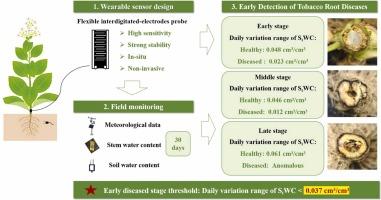基于可穿戴植物传感器的烟草根系病害早期原位检测
IF 6.2
1区 农林科学
Q1 AGRICULTURAL ENGINEERING
引用次数: 0
摘要
黑胫病和根腐病是烟草最具破坏性的病害。一旦发生,就会迅速蔓延,危及烟草植株的健康,甚至导致烟草植株死亡。烟草根系附近的茎是最早表现出可观察到的根系病害征兆的部位。监测根系附近原位茎含水量的动态变化,有利于烟草根系病害的早期发现。为此,我们开发了一种可穿戴植物传感器,采用柔性交叉数字电极(IE)探针设计,用于StWC的原位监测和烟草根系病害的早期识别和预警。将可穿戴式传感器的IE探头固定在茎上,土壤湿度(SM)传感器埋设在相应的根部区域。结果表明,在观察到的患病烟草和健康烟草根部附近的StWC之间的趋势明显不一致。在根茎发黑前60 h左右,病株的SM(0.007 cm3/cm3)比健康株的SM(0.021 cm3/cm3)下降较慢。根据这一现象,病株根附近StWC的日变化(0.023 cm3/cm3)显著小于健康株(0.048 cm3/cm3)。此外,患病烟草植株黑化后根系附近StWC的异常变化进一步验证了可穿戴传感器在烟草根系病害早期检测预警中的有效性。当StWC的日变化连续小于0.037 cm3/cm3时,烟草植株可能处于早病期。未来的研究重点将集中在烟草根系附近土壤与茎之间的水分传导机制,以及可穿戴传感器在早期疾病检测中的潜在应用。本文章由计算机程序翻译,如有差异,请以英文原文为准。

Early in-situ detection of tobacco root diseases using a wearable plant sensor
Black shank disease and root rot disease represent the most destructive diseases of tobacco. Once it occurs, it will spread rapidly, endangering the health of tobacco plants, and even killing them. The stem near the root of tobacco plant is the first part that can exhibit observable signs of root disease. Monitoring the dynamic variations of in-situ stem water content (StWC) near the root is beneficial for the early detection of tobacco root diseases. Therefore, we developed a wearable plant sensor with a flexible interdigitated-electrodes (IE) probe design for in-situ monitoring of StWC and early identification and warning of tobacco root diseases. The IE probe of wearable sensor was securely affixed to the stem, and the soil moisture (SM) sensors were buried in the corresponding root area. The results demonstrated a clear inconsistency in the observed trend between the StWC near roots of diseased and healthy tobacco plants. About 60 h before the blackening of the stems near roots, the SM of diseased tobacco plants (0.007 cm3/cm3) indicated a slower decrease compared to healthy tobacco plants (0.021 cm3/cm3). In accordance with this phenomenon, the daily variation of StWC near roots of diseased tobacco plants (0.023 cm3/cm3) was significantly less than that of healthy tobacco plants (0.048 cm3/cm3). Moreover, the abnormal changes of StWC near roots of diseased tobacco plants after blackening further validated the availability of the wearable sensor in the early detection and warning of tobacco root diseases. The tobacco plant may have been in early diseased stage when the daily change of StWC was continuously less than 0.037 cm3/cm3. Future research will focus on the mechanism of water conduction between soil and stem near the root of tobacco plants, and the potential application of the wearable sensor in early disease detection.
求助全文
通过发布文献求助,成功后即可免费获取论文全文。
去求助
来源期刊

Industrial Crops and Products
农林科学-农业工程
CiteScore
9.50
自引率
8.50%
发文量
1518
审稿时长
43 days
期刊介绍:
Industrial Crops and Products is an International Journal publishing academic and industrial research on industrial (defined as non-food/non-feed) crops and products. Papers concern both crop-oriented and bio-based materials from crops-oriented research, and should be of interest to an international audience, hypothesis driven, and where comparisons are made statistics performed.
 求助内容:
求助内容: 应助结果提醒方式:
应助结果提醒方式:


